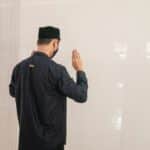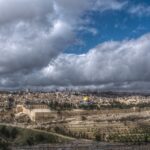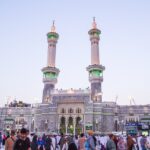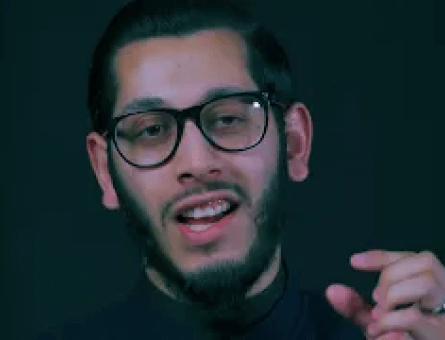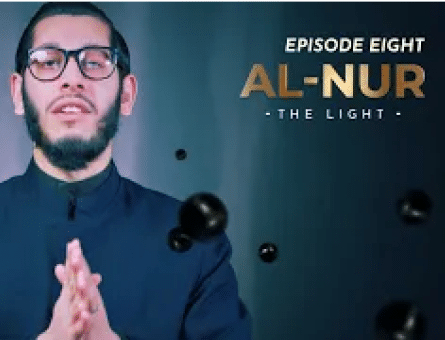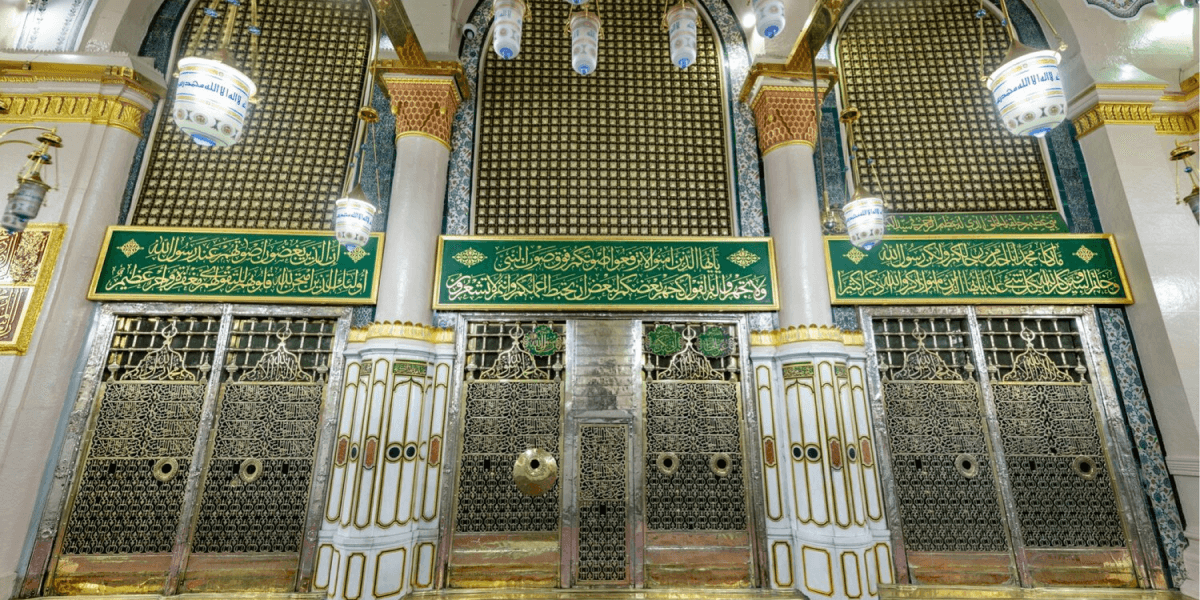Rawdah Mubarak – The Sacred Chamber
Located in the southeastern section of Masjid e-Nabawi (The Mosque of Prophet Muhammad (PBUH)), Rawdah Mubarak is one of the most venerated tombs in the world.
It is marked by a beautiful golden grill and is the burial place of Prophet Muhammad (PBUH) and two of his beloved companions and the first two Caliphs of Islam, Abu Bakr al-Siddiq (RA) and Umar bin Al-Khattab (RA). Here is everything you need to know about Rawdah Mubarak.
What Is Rawdah Mubarak?
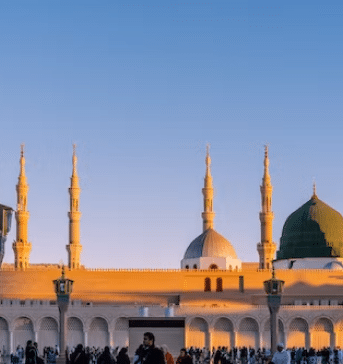 Otherwise known as al-Rawdah al-Shareef, meaning “The Exalted Garden”, Rawdah Mubarak is of the Riyadhul Jannah (Gardens of Paradise) and refers to the area between the house of Prophet Muhammad (PBUH) and Aisha (RA) and the Minbar (Pulpit) of Prophet Muhammad (PBUH). The Messenger (PBUH) of Allah SWT said, “The area between my house and my pulpit is one of the gardens of Paradise.” (Bukhari)
Otherwise known as al-Rawdah al-Shareef, meaning “The Exalted Garden”, Rawdah Mubarak is of the Riyadhul Jannah (Gardens of Paradise) and refers to the area between the house of Prophet Muhammad (PBUH) and Aisha (RA) and the Minbar (Pulpit) of Prophet Muhammad (PBUH). The Messenger (PBUH) of Allah SWT said, “The area between my house and my pulpit is one of the gardens of Paradise.” (Bukhari)
According to Islamic history, Rawdah Mubarak was originally the house (hujra) of Aisha (RA) and the house in which Prophet Muhammad (PBUH) stayed at the time of his death.
Highlighting the significance of visiting the Rawdah Mubarak, the Messenger (PBUH) of Allah SWT said, “Whoever visits me after my death is like he who had visited me during my life.” (Tabraani)
“The Rawdah is part of the Prophet’s (PBUH) mosque, and the prayer in it equals in reward of 1,000 prayers. However, there is no doubt that the Rawdah is of more excellence because the Prophet distinguished it and did not distinguish any other parts of the mosque for being a garden from the gardens of Paradise.” (Bukhari)
“Whoever performs his Hajj in Makkah, then comes to Madinah with the sole aim of visiting me in my Masjid, for him shall be written (the rewards of) two accepted Hajj.” (Daylami)
“When a person stands at my grave reciting blessings on me, I hear it; and whoever calls for blessings on me in any other place, his every need in this world and in the hereafter is fulfilled, and on the day of Qiyamah I shall be his witness and intercessor.” (Bayhaqi)
Therefore, when visiting Rawdah Mubarak, make sure that you offer two Rakat Nafl prayers, preferably behind the Pillar of Aisha (RA), make lots of dua for yourself and your loved ones, ask for forgiveness near the Pillar of Repentance, and send an abundance of Salawaat on the Messenger (PBUH) of Allah SWT.
What Is Inside the Rawdah Mubarak?
The Sacred Chamber is split into two sections. Inside the Rawdah Mubarak are the graves of Prophet Muhammad (PBUH), Abu Bakr al-Siddiq (RA), and Umar ibn al-Khattab (RA). However, outside it are the boundaries of the house of Fatima (RA), where you can find and touch the clothes of the beloved Prophet Muhammad (PBUH) hanging on the wall.
Who’s Buried Next to Prophet Muhammad (PBUH)?
Alongside the grave of Prophet Muhammad (PBUH) are the graves of two of his closest companions and the first two Caliphs of Islam, Abu Bakr al-Siddiq (RA) and Umar ibn al-Khattab (RA). Here is everything you need to know about the graves of the beloved companions:
Abu Bakr al-Siddiq (RA)
Before passing away, Abu Bakr al-Siddiq (RA) left a will with his daughter Aisha (RA), in which he requested to be buried alongside Prophet Muhammad (PBUH). Abu Bakr al-Siddiq (RA) died at the age of 63 in Jamad al-Ukhra in 13 AH.
He remained Caliph for two and half years and was the first Caliph in the history of Islam. During the period of Abu Bakr al-Siddiq (RA) ‘s sickness, Umar (RA) led the congregational prayer and was later selected to serve as the second Caliph of Islam.
Umar ibn al-Khattab (RA)
According to Islamic history, the second Caliph Umar bin Al-Khattab (RA) was stabbed by Piruz Nahavandi (also known as Abu Lulu) while performing the Fajr prayer on the 27th or 26th of Dhul Hijjah. Piruz Nahavandi was a Persian slave who first killed Umar (RA) and then committed suicide. However, it is said that shortly before his death, Caliph Umar bin Al-Khattab (RA) said to his son, Abdullah (RA): “Go to the mother of the believers, Aisha (RA), and say, ‘Umar bin Al-Khattab sends his greetings to you,’ and request her to allow me to be buried with my two companions.”
Listening to this, Aisha (RA) replied, “I had the idea of having this place for myself, but today I will give preference to him over myself.” When he returned, he said: “She has allowed you (to be buried there).” On that, Umar bin Al-Khattab (RA) said: “Nothing was more important to me than to be buried in that (sacred) place.”
Umar bin Al-Khattab (RA) died on Muharram 1, 24 AH. His tenure as the second Caliph of Islam lasted ten and a half years and is known as the most significant decade in the establishment of Islam. Suhaib (RA) led the funeral prayer of Caliph Umar bin Al-Khattab (RA), after which he was buried in the Sacred Chamber.
It is said that during the burial process, Aisha (RA) placed a partition between the area occupied by the graves and the rest of the room as Umar (RA) wasn’t mahram to her.
Architecture and Dimensions
“The Noble Garden,” or the Rawdah Mubarak, is the area between the minbar (pulpit) and the house of Prophet Muhammad (PBUH) and Aisha (RA). It is rectangular in shape and measures 15 metres in breadth (north to south) and 26.5 metres in length (east to west).
A 22-metre–wide part of Rawdah Mubarak lies in the Sacred Chamber and it is the only accessible area of the Prophetic chamber. Rawdah Mubarak covers a total area of 397.5 square metres. The walls of Rawdah Mubarak are 3 metres high and were built by Al-Zahir Baybars (RA) in 678 AH (1282 AD).
However, the walls were later reconstructed by Sultan al-Ashraf Qitbay (RA) in 886 AH (1481 AD) using iron railings.
Distinguishable from Masjid e-Nabawi by its 2-metre long, white marble columns covered in gold, the Rawdah Mubarak is the burial ground of Prophet Muhammad (PBUH), Abu Bakr (RA), and Umar (RA).
The southern and northern sides of Rawdah Mubarak are 16 metres long, and the eastern and western sides are 15 metres in length.
Dimensionally, from the eastern side, Rawdah Mubarak borders the house of Aisha (RA). From the southern side, it borders the Qibla, from the western side, it borders the pulpit and a parallel line to the end of Aisha’s (RA) house from the northern side.
Although there are no doors and windows on the walls of the burial area of Rawdah Mubarak, there are three viewing holes on the walls of Rawdah Mubarak. The largest hole on the left directly faces the grave of Prophet Muhammad (PBUH). The viewing hole in the middle faces the grave of Abu Bakr (RA), and the hole on the right faces the grave of Umar (RA).
However, a lesser-known fact about Rawdah Mubarak is that there is a spot for a fourth grave which according to Islamic scripture will eventually be the grave of Prophet Isa (AS). Abdullah bin Salam (RA) said, “The characteristics of Prophet Mohammad (PBUH) are described in the Old Testament and it is also mentioned there that Isa (AS) will be buried with him.”
The area of Rawdah Mubarak is surrounded by the Sacred Chamber which comprises six pillars and four doors, each of them demarcated with green copper and gold and iron railings. The names of the Prophetic Chamber’s doors are as follows:
- The Door of Tahajjud (Bab al-Tahajjud) is located on the northern side, near the Mihrab of Tahajjud.
- The Door of Repentance (Bab al-Tawah) is located on the southern side.
- The Door of Aisha (Bab Aisha) is located on the western side, next to the Pillar of Delegation.
- The Door of Fatima (Bab Fatima) is located on the eastern side, adjacent to the house of Fatima (RA).
What Is the Importance of the Rawdah Mubarak?
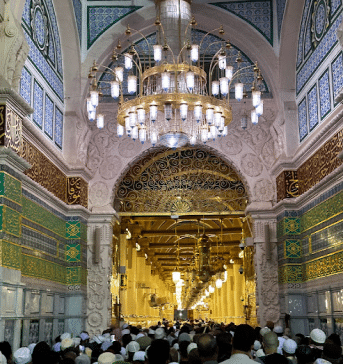 Rawdah Mubarak is the burial place of the last messenger of Allah SWT, Prophet Muhammad (PBUH). It is a highly venerated site in Islam and is visited by millions of Muslims every year.
Rawdah Mubarak is the burial place of the last messenger of Allah SWT, Prophet Muhammad (PBUH). It is a highly venerated site in Islam and is visited by millions of Muslims every year.
Rawdah Mubarak – The Garden of Paradise
Prophet Muhammad (PBUH) said, “The area between my house and my pulpit is one of the gardens of Paradise.” (Bukhari)
In light of the above-mentioned hadith, Imam Ibn Hajr Al-Asqalani (may Allah SWT have mercy on him) said that the meaning of Rawdah is the “Garden of Paradise”, also known as “Riyad Al-Jannah.”
According to Islamic scholars, this can mean any of the following:
- Rawdah Mubarak is an area similar to paradise in that it is blessed and peaceful.
- Worshipping at Rawdah Mubarak will lead to paradise.
- The land on which Rawdah Mubarak is will be transferred to paradise on the Day of Judgement.
Prayers Are Granted at Rawdah Mubarak
Salmah Bin Akwah (may Allah be pleased with him) reported that Prophet Muhammad (PBUH) was particular in praying at the Rawḍah. (Bukhari)
The Messenger (PBUH) of Allah SWT also said, “When a person stands at my grave reciting blessings on me, I hear it; and whoever calls for blessings on me in any other place, his every need in this world and in the hereafter is fulfilled, and on the day of Qiyamah I shall be his witness and intercessor.” (Bayhaqi)
Therefore, you should follow the Sunnah of Prophet Muhammad (PBUH) and spend time in the Rawdah Mubarak worshipping Allah SWT, praising Him, showing gratitude, and seeking forgiveness and repentance for your sins.
According to the General Presidency for the Affairs of the Two Holy Mosques, men who wish to pray in Rawdah Mubarak will be permitted to perform prayer in two shifts: from midnight to the Fajr prayer and from the Duhr prayer to the Isha prayer.
The Reward for Praying in Rawdah Mubarak Is Equivalent to Two Accepted Hajj
The Messenger (PBUH) of Allah SWT said, “Whoever performs his Hajj in Makkah, then comes to Madinah with the sole aim of visiting me in my Masjid, for him shall be written (the rewards of) two accepted Hajj.” (Daylami)
So, if you are planning to go to Makkah with the intention to perform a pilgrimage (Hajj or Umrah), make sure to visit Masjid-e-Nabawi in Madinah and pray near the Rawdah Mubarak to earn an immense reward.
“The Rawdah is part of the Prophet’s (PBUH) mosque, and the prayer in it equals in reward of 1,000 prayers. However, there is no doubt that the Rawdah is of more excellence because the Prophet distinguished it and did not distinguish any other parts of the mosque for being a garden from the gardens of Paradise.” (Bukhari)
Sacred Pillars
Marked by large green circles with golden inscriptions, there are six pillars of the Rawdah Mubarak. The names of the sacred pillars are as follows:
- Pillar of Casting Lots (Ustuwanah al-Qurah) or Pillar of Aisha (Ustuwanah Aisha) or Pillar of Emigrants (Ustuwanah al-Muhajireen)
- Pillar of Abu Lubabah (Ustuwanah Abu Lubabah) or Pillar of Repentance (Ustuwanah al-Tawbah)
- Pillar of Delegations (Ustuwanah al-Wufud)
- Pillar of Ali Ibn Abi Talib (Ustuwanah Ali ibn Ali Talib) or Pillar of the Guard (Ustuwanah al-Haras)
- Pillar of the Bed (Ustuwanah al-Sarir)
- Weeping Pillar (Ustuwanah al-Hannana) or Perfumed Pillar (Ustuwanah al-Mukhallaqah)
Summary – Rawdah Mubarak
Whether going for Hajj or Umrah, during their visit to Makkah, Saudi Arabia, pilgrims make sure to visit the Rawdah Mubarak in Masjid e-Nabawi (Mosque of Prophet Muhammad (PBUH)) in Madinah. It is located between the house of Prophet Muhammad (PBUH) and Aisha (RA) and the Prophet’s (SAW) Minbar (pulpit). Rawdah Mubarak is 15 metres wide and 22 metres in length.
From the eastern side, Rawdah Mubarak borders the house of Aisha (RA), from the southern side it borders the Qibla, from the western side it borders the pulpit, and a parallel line from the northern side connects with the end of Aisha’s (RA) house.
When visiting Masjid-e-Nabawi, Muslims are always keen to perform Nafl prayers in Rawdah Mubarak as the reward is equivalent to that of a thousand prayers or even two Hajj.
Explore The New Pilgrim App
The Ultimate App
for Hajj and Umrah!





